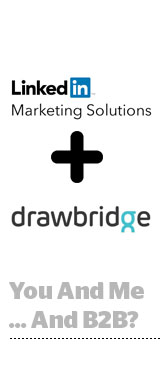
LinkedIn is buying Drawbridge.
The acquisition was announced quietly on Tuesday via a mere mention buried in a blog post, and the deal price was undisclosed. The deal is expected to close by the end of June.
Drawbridge CEO Kamakshi Sivaramakrishnan and CTO Devin Guan are coming aboard, although LinkedIn declined to share which other and how many Drawbridge employees will also join.
The company raised $70 million since it was founded in 2011, and its headcount has declined more than 30% over the last two years, according to LinkedIn Premium data.
With the acquisition, the last of the scaled independent cross-device identity companies finds a home after a tough few years. Drawbridge closed its London office in the lead up to GDPR and sold off its managed media business to location data platform Gimbal in May of last year.
In a previous interview, Sivaramakrishnan characterized both moves as an exit from the ad tech business motivated by a desire for strategic focus rather than a response to headwinds.
But there’s no doubt that the probabilistic approach to cross-device identity matching is more embattled now than ever as the browsers crack down on tracking cookies and fingerprinting.
Which begs the question: Why is LinkedIn acquiring Drawbridge?
According to LinkedIn, the Drawbridge “team and technology will allow us to accelerate the capabilities of our Marketing Solutions platform, helping our customers better reach and understand their professional audiences and measure the ROI of their campaigns across mobile and desktop.”
Once the transaction closes, the Drawbridge technology will be integrated into LinkedIn.
Reading between the lines, there is a whiff of acqui-hire here. Finding ad tech talent isn’t easy, particularly on the product side.
But LinkedIn is also looking to beef up its Audience Network and do more with better look-alike audience modeling outside of its garden walls.
The Drawbridge technology will help LinkedIn expand the reach of its matched audiences through Audience Network campaigns and enable better attribution to help advertisers more effectively target and then measure the results they’re getting from LinkedIn campaigns across channels and devices, a LinkedIn spokesperson told AdExchanger.
And LinkedIn needs to move fast. Perhaps because of its B2B focus and contained B2B marketing universe, LinkedIn has some catching up to do with the other large audience networks out there, like Google and Facebook, said Joe Stanhope, a VP and principal analyst at Forrester.
“LinkedIn needs speed to market,” Stanhope said. “They have scads of data, especially in the context of a B2B social network, and they have smart people, so I’m sure they could ramp this up quickly if they wanted to, but if they can cut a year of development time, what is that worth to them? Clearly, there is pressure for LinkedIn to accelerate its overall marketing platform performance and progress.”
Still, it’s an odd pairing.
LinkedIn’s bread and butter comes from its logged-in audience of professionals, and Drawbridge isn’t known for its B2B chops.
But it makes sense from a measurement perspective, Stanhope said.
“LinkedIn is blessed is that people use it a lot, but cursed in that they use it across a huge number of devices in different places: at home, in the office, on their phone, on an iPhone, on desktop,” he said. “This acquisition could help them really strengthen their conversion tracking across different topics.”
LinkedIn’s internal data does show that mobile accounts for the majority of ad engagement, while most of the conversions happen on desktop, the company spokesperson said, noting that “the Drawbridge technology is going to help us better connect mobile and desktop experiences.”
Still, the deal is surprising to at least one executive in the cross-device industry, especially considering LinkedIn’s strict stance on user privacy.
And just buying a platform to enable user matching across multiple browsers and devices for LinkedIn’s Audience Network solution doesn’t “justify the purchase of a company which has raised roughly $70 million,” said the executive, who wished to remain anonymous.
This post was syndicated from Ad Exchanger.


More Stories
Creativity shines
Hilton Uses Social Listening to Showcase ‘Superior’ Stays
Spring surge of members for World Out of Home